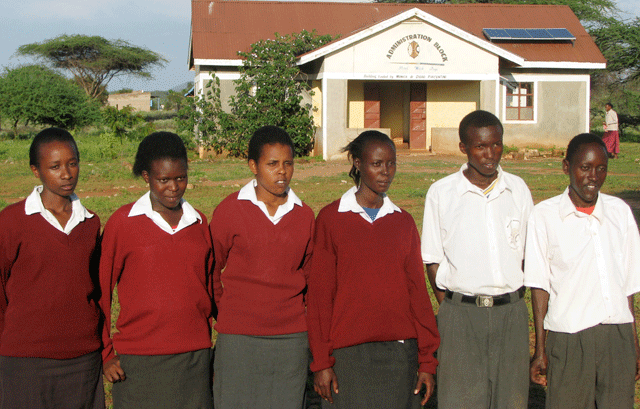Maasai
High School, Merrueshi
Education
is the Key to Development.
We
are creating leaders for tomorrow
Maasai
High School is in the Maasai region of Kenya, approximately
160 km southeast of Nairobi, Kenya and 100 km north of the
Kenya and Tanzanian border. The entire school was build by
Maasai Association.

Picture
above: class of 2010
Facilities
•
Four classrooms
• Administration block
• Dormitory facilities (one for boys and one for girls)
• A kitchen
• Teachers' houses
The
entire school has sufficient water and power supply from solar
energy.
Students
The
school has over 200 students, boys and girls, from all corners
of Maasai land. The students range from 14 to 18 years of
age.
Teachers
The school
has 10 teachers. Maasai Association employs 50% of the teachers.
The government pays the rest.
Management
The school
is managed by a board, a group of 12 men and women, collectively
nominated by members of Merrueshi community. The ministry
of education has some representative in the board.
Community
members work to achieve the following:
-
Education
that meets national standards
-
Community
empowerment through Western and Maasai integrated learning
system
-
Global
awareness
-
Education
that is culturally sensitive to the Maasai way of life
The
community encourages self-discipline rather than discipline
through foreign rules. Younger students are encouraged to
become positive role models for future generations. This idea
cultivates the Maasai traditional principle of intergenerational
support system.

The Maasai depends on its generations. Future generations
depend on efforts from fore generations. A successful community
depends on responsible and proud citizens, which depends on
a community of good morale and values.
Today's
children are leaders for tomorrow. It is important to educate
Maasai children and enable them to make a strong contribution
to the ongoing needs of their community.This philosophy nurtures
the values of a strong community.
Maasai
High School is not affiliated with any religious or political
organization, and does not discriminate against gender, race,
color, or religion.
Curriculum
The
curriculum is made up of the following subjects
•
Language Skills: Maasai, Swahili, and English
• Mathematics
• Biology science
• Physics
• Chemistry
• Geography, History and Government
• Cultural Subjects, Business Education, Accounts,
• Commerce, Economics
Extra
curricula activities
The
integration of western and Maasai educational learning systems
is vital to the survival of the Maasai people, following the
priorities, needs and interest of the Maasai community. Such
an integrated system allows Maasai children to contribute
effectively in this rapidly changing world.
Each villager with a child in school has to sell a goat, sheep
or cow in order to meet school fees for their children. Each
child pays $150 dollars, tuition, per term. This amount is enough
to cover tuition and boarding fees. It
is mandatory for each student to wear school uniform in Kenya’s
public school.
